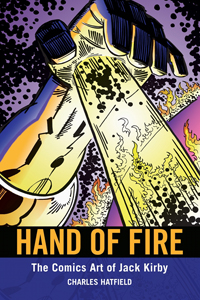For almost 80 years, Kirkus Reviews has served as the industry bible for bookstore buyers, librarians, and ordinary readers alike. Now Popdose joins the Kirkus Book Bloggers Network to explore the best — and sometimes the worst — in pop-culture and celebrity books.
With The Avengers about to hit movie theaters, we take a moment to consider the maker of the myths — the man they called “The King” — and his far-flung legacy…
 Criticism is a touchy subject at the best of times, but subjecting popular culture to academic analysis is particularly dicey. With most of the commercial arts — film, TV, comic books, pop music, comedy — the pleasures of the product are primarily experiential. Populist works are by design neither dense nor particularly allusive, because those mediating qualities make it more difficult to ”enter” a work; and so they neither beg for nor benefit from intensive explication. No work is entirely without subtext, of course, but for the most part populist art makes a virtue of being immediate and immersive; you have to experience it for yourself to really get it. Trying to nail that experience down can be like pinning a butterfly to a card — killing the very thing you wish to examine.
Criticism is a touchy subject at the best of times, but subjecting popular culture to academic analysis is particularly dicey. With most of the commercial arts — film, TV, comic books, pop music, comedy — the pleasures of the product are primarily experiential. Populist works are by design neither dense nor particularly allusive, because those mediating qualities make it more difficult to ”enter” a work; and so they neither beg for nor benefit from intensive explication. No work is entirely without subtext, of course, but for the most part populist art makes a virtue of being immediate and immersive; you have to experience it for yourself to really get it. Trying to nail that experience down can be like pinning a butterfly to a card — killing the very thing you wish to examine.
But if there’s any pop artist who can stand up to the rigors of academic dissection and flap away unscathed, it is comic book legend Jack Kirby (1917-1994), whose legacy is explored in Charles Hatfield‘s new study Hand of Fire: The Comics Art of Jack Kirby. It was Kirby, more than anyone, who codified the grammar of comics, who gave the medium its immediacy, its narrative oomph. In his mature work, that visceral punch is married to a rare thematic depth and unity that invites close reading and examination. The wonder of it is that Hand of Fire is the first full-length scholarly study of Kirby’s work. Professor Hatfield has written a book that is both welcome and long overdue.
Hatfield is that rare creature — an academic who writes plainly and with panache. Too much academic writing on art dissolves into a hail of buzzwords, forcing an artist into a particular theoretical framework — not so much pinning the butterfly as breaking it on the wheel. Hatfield treads lightly around the jargon. When he does evoke semiotic theory, he does so playfully, staging the encounter between artist and theorist as an opportunity to interrogate the limits and usefulness of the theory itself. (It’s more fun than it sounds.) In the main, though, he confronts Kirby in the context of his themes and their intersection with his biography.
And the history of Kirby is the history of comics itself, as both artform and industry. Upon his death, Kirby left behind a staggering body of work — an estimated 81,000 pages of comics — dating from the infancy of the medium to its auteurist heyday. Much of that original work is now gone forever, either purposely destroyed or lost to the ravages of time; much more has never been reprinted. But even using only the volumes of Kirby’s work currently available in mass-market editions — volumes that represent a tiny fraction of his total output — you could easily fill a nine-foot shelf; and those works that directly derive from and build upon Kirby’s characters and concepts would fill a whole library. Kirby created or co-created some of comics’ most iconic properties: Captain America, the Fantastic Four, Thor, the Avengers, Darkseid, the Hulk, the Silver Surfer, and the X-Men, to name only a few.
Read the rest of this article at Kirkus Reviews!





Comments